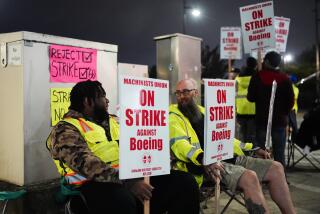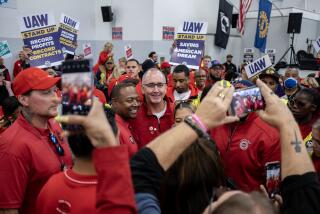Effect of GM Strike Reaches Truck Plants
DETROIT — The effect of a weeklong strike at two Ohio brake plants spread to the most profitable part of General Motors Corp.’s vehicle business Monday, forcing the company to idle nearly half its 29 assembly plants and furlough about 51,000 workers nationwide.
In what amounts to a preview of this year’s national labor negotiations between the United Auto Workers Union and Detroit’s Big Three, GM and the union remain far apart on a dispute about sending work to outside suppliers. No formal talks are scheduled.
The contract dispute began March 4 with the walkout of 2,700 workers at two GM brake plants in Dayton. The strike’s main issue--known in industry jargon as outsourcing--promises to be the centerpiece of the triennial contract talks scheduled to begin in September.
Already in the last two years, the auto maker’s attempts to farm out more work to lower-cost producers has prompted several successful UAW strikes. So important does the union consider the issue that some labor experts predict that a failure to resolve it could lead to a national strike later this year against one of the Big Three.
“Bringing up this issue at the onset of national negotiations is like raising a red flag in front of a bull,” said Dale Brickner, a labor professor at Michigan State University.
The strike also highlights how their greater manufacturing efficiency has made U.S. auto makers more vulnerable to union pressure. GM now relies on fewer suppliers and does not stockpile parts. Thus a work stoppage at a single plant that makes a crucial part can quickly stall the whole company.
Until Monday, the strike had mostly closed car plants. Since GM dealers generally have more cars on hand than they can sell, and since the plants were not running at capacity, the stoppages had little financial effect on the company.
But Monday’s forced shutdowns of truck plants in Pontiac, Mich., and Fort Wayne, Ind., have stepped up pressure on GM to return to the bargaining table. The reason is that GM’s trucks, particularly its pickups such as the Chevrolet C/K and sport-utility vehicles such as the GMC Jimmy, are among its most popular and profitable vehicles.
The stakes have also been raised by the idling of the Spring Hill, Tenn., plant where GM makes its popular Saturn subcompact. Unlike at the other plants where idled workers are being laid off, Saturn said it would reassign its 7,300 union workers to training programs until the labor dispute is settled.
A prolonged strike could mean that GM will lose valuable market share to Ford Motor Co. and Chrysler Corp., particularly in the truck market. Lost truck sales would soon be felt on the bottom line.
Even if a quick settlement is forged, it is clear that attempts to shift work to outside suppliers, particularly to nonunion shops, will continue to be a major bone of contention between the auto makers and the UAW.
Outsourcing is not a new issue, but it has often been overshadowed by disputes over wages and benefits. It has proven to be intractable in part because it is complex and emotional. For the UAW, “outsourcing” is a code word for downsizing--another way to eliminate high-paying manufacturing jobs or force workers to accept concessions.
The Big Three have differing stakes in seeking to send work outside. Chrysler makes only 30% of its own parts, Ford about 50% and GM about 70%. This puts GM at a cost disadvantage because its unionized parts workers are generally paid more than workers for outside contractors.
“We would prefer to do things within our own facilities,” GM spokesman Gerald Holmes said, “but with our wage levels, there are some things we cannot do competitively.”
As part of its restructuring, GM has sold off some uncompetitive parts operations in recent years. In some cases, it has worked with the UAW to identify ways to keep other plants open by making them more efficient.
At GM’s Delphi Chassis Systems plants in Dayton, the union maintains that the company has reneged on promises made in 1994, after another short strike, to hire more workers and bring more work into the two plants. Instead, the union says, GM has threatened to take work outside and eliminate 125 existing jobs.
“They are already working our people to death with overtime, and this would make it worse,” said Tom Lewis, strike chairman for UAW Local 696.
GM officials say the company has lived up to its commitments on staffing levels but that the UAW has not met productivity goals it agreed to.
Whatever the truth, the situation is not an unfamiliar one to GM. This is the eighth local strike it has faced since 1994, most involving outsourcing, and the union appeared to prevail in each case.
GM has been so persistent because “they want to show to the Wall Street smart guys that they really are trying to lower costs but there is this crazy union out to kill them,” said Sean McAlinden, a labor economist for the University of Michigan.
The UAW, however, has weakened that argument in this strike by agreeing to allow 300 workers to continue making brakes in Dayton for Chrysler and Isuzu. The message: The UAW will work for good customers, not bad ones.
Mary Ann Keller, an analyst with Furman Selz, faults GM for failing to develop a credible strategy to resolve the issue of using outside suppliers.
“We have seen GM and the rest of the industry capitulate every time they take on this issue,” she said.
Still, GM appears intent on pressing the issue, perhaps in an effort to settle it before the UAW picks a negotiations target for the September talks.
GM may fear that if the UAW picks Chrysler, the union will be more likely to win a deal that bars outsourcing, and would then try to impose the same contract on GM.
“GM could be in a position that its outsourcing policy is dictated by someone else,” Keller said.






